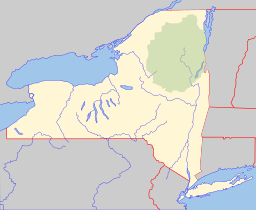| Keuka Lake | |
|---|---|
 View of Keuka Lake | |
| Location | Steuben / Yates counties, New York, United States |
| Group | Finger Lakes |
| Coordinates | 42°29′47″N 77°08′46″W / 42.49639°N 77.14611°W |
| Type | Ground moraine |
| Primary inflows | Keuka Inlet, Sugar Creek, Glen Brook, Wagener Glen Creek |
| Primary outflows | Keuka Lake Outlet |
| Basin countries | United States |
| Max. length | 20 mi (32 km) |
| Max. width | 0.5 to 2 mi (0.80 to 3.22 km) |
| Surface area | 11,730 acres (47.5 km2) |
| Average depth | 101 ft (31 m) |
| Max. depth | 187 ft (57 m) |
| Water volume | .35 cu mi (1.5 km3) |
| Shore length1 | 60 mi (97 km) |
| Surface elevation | 715 ft (218 m)[1] |
| Settlements | Penn Yan Hammondsport Branchport |
| 1 Shore length is not a well-defined measure. | |
Keuka Lake (/ˈkjuːkə/ KEW-kə) is one of the major Finger Lakes in the U.S. state of New York. It is unusual because it is Y-shaped, in contrast to the long and narrow shape of the other Finger Lakes. Because of its shape, it was referred to in the past as Crooked Lake. Keuka means 'canoe landing' or 'lake with an elbow' in the Seneca language. The first white settlers to the lake region came after the Sullivan Expedition during the American Revolutionary War. In 1833 the Crooked Lake Canal was completed, connecting Keuka Lake with Seneca Lake, connecting with the Erie Canal. Beginning in the first half of the 19th century many steamboats operated on the lake which largely functioned as transports between Penn Yan and Hammondsport, often in service of the wine industry. In 1872 the Bath & Hammondsport Railroad, connecting to the Erie Railroad, went into operation, replacing the use of the canal. Beginning in the mid 19th century the lake has since been surrounded by vineyards and wineries which earned it the title, the Cradle of the Wine Industry, in New York. During the beginning of the 20th century the first water-craft airplanes were developed and tested on Keuka Lake by aviation pioneer Glenn Curtiss.
- ^ "Keuka Lake". Geographic Names Information System. United States Geological Survey, United States Department of the Interior. Retrieved June 9, 2015.

